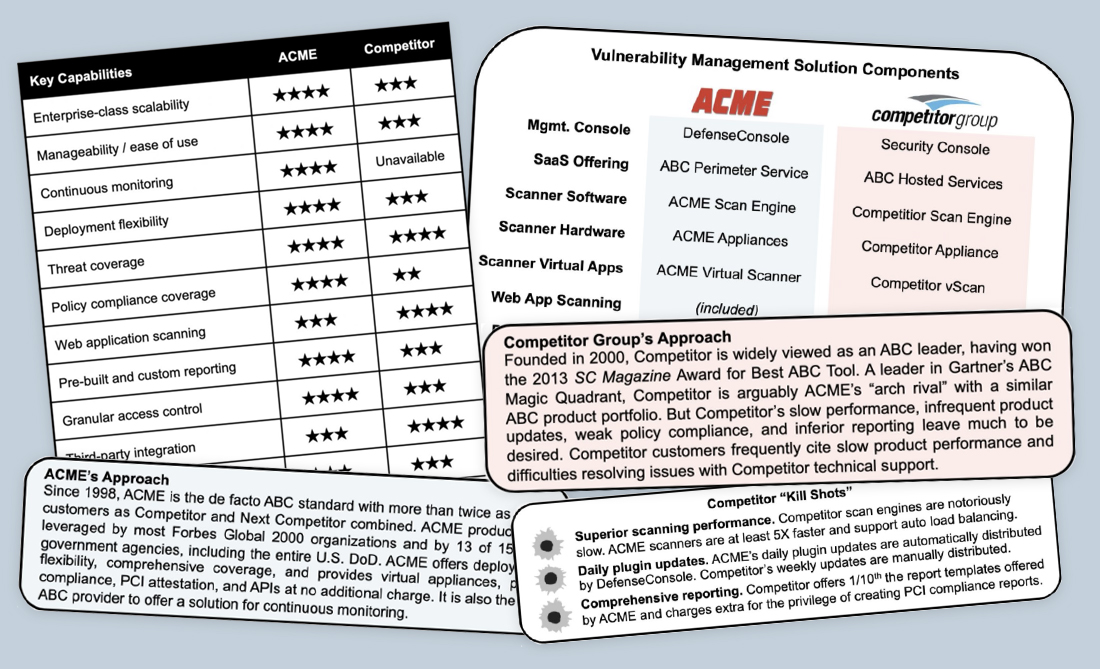
Blog
Key Components of Competitor Battlecards

Salespeople love competitor battlecards. There’s no two ways about it. And it’s important that you provide comprehensive competitor battlecards to your sales force and channel partners (if applicable) that feature accurate, up-to-the-minute competitive intelligence.
However, creating competitor battlecards is an art. Most battlecards are created in Microsoft PowerPoint as they’re easy to create and modify and you don’t have to bother a graphic designer to make changes. One of the biggest challenges is being succinct – conveying complex topics in as few words as possible as you usually only have two pages (i.e., PowerPoint slides) to work with. So, it’s important that you carefully select section headings that provide the biggest bang for the buck.
As CyberEdge, most of the competitor battlecards that we create for our technology vendor clients feature the following sections:
- Sponsor’s Approach: A short paragraph saying whatever you’d like about your company’s products, services, or key advantages. (Replace “Sponsor” with your company name.)
- Competitor’s Approach: A short paragraph saying whatever you’d like about your competitor’s products, services, and key advantages and/or disadvantages. (Replace “Competitor” with your competitor’s company name.)
- Key Advantages: Three succinctly worded key advantages that your company has over this specific competitor. Some vendors call these “Kill Shots,” but in this day in age, that might not be the best idea. Regardless of what you call them, we’re talking about three key advantages that, ideally, every salesperson should memorize. (It’s easiest to remember things in threes.)
- Key Capabilities table: Include a table of key capabilities with two columns – your company and the competitor. It’s up to you whether you use Harvey balls (i.e., Consumer Reports-style rating circles), up to four stars, or check marks and X’s. Just be sure the table isn’t entirely stacked in your favor to ensure the battlecard doesn’t lose credibility.
- Solution Components: If your solution and/or your competitor’s solution is comprised of multiple products and/or technology components, then perhaps include a table so it’s clear what each product or component is called.
- Sponsor Advantages: A list of advantage names and descriptions preferably in decreasing order of revenue impact. (Replace “Sponsor” with your company name.)
- Competitor Advantages: A list of advantage names and descriptions preferably in decreasing order of revenue impact. (Replace “Competitor” with your competitor’s name.) We recommend that you also include a short response statement so your salespeople know what to say if their prospect raises a given competitor advantage as a concern.
- Competitor FUD: What “FUD” (fear, uncertainty, and doubt) is your competitor saying about your company and/or offerings? List them here and provide responses for your salespeople correcting the record.
- Setting Landmines: What questions would you like your salesperson to pose to their prospect if they’re the first one into the account? If you they ask the questions the right way, they’ll be stacking the deck in their favor before their competitor engages with your prospect. (Alternative section heading: Setting Sandtraps.)
Your competitor battlecards are not customer-facing. They are for internal and channel partner (if applicable) sales personnel only. And be sure to reference “company confidential” or comparable statement in the footer on each page.
Also, be sure to keep your competitor battlecards current with accurate competitive intelligence. Every time your competitor updates their stuff or your company updates your stuff, the associated battlecard should be updated.
For more information about CyberEdge’s competitor battlecard offering, click here: https://cyber-edge.com/services/competitor-battlecards/
To request sample anonymized battlecards from CyberEdge, drop us an email at info@cyber-edge.com.


